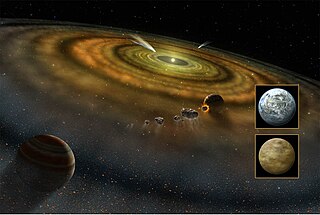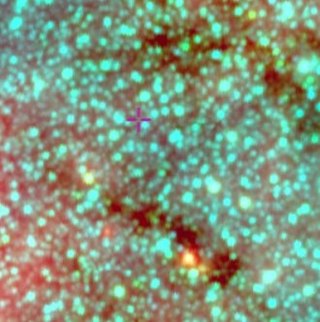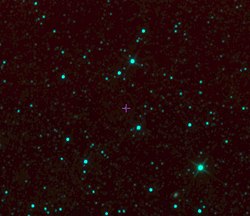
In astronomy, a light curve is a graph of the light intensity of a celestial object or region as a function of time, typically with the magnitude of light received on the y-axis and with time on the x-axis. The light is usually in a particular frequency interval or band.

Astraea is an asteroid in the asteroid belt. This object is orbiting the Sun at a distance of 385 million kilometres (2.5735 AU) with a period of 4.13 yr and an orbital eccentricity of 0.19. The orbital plane is inclined at an angle of 5.37° to the plane of the ecliptic. It is spinning with a period of 16.8 h. The surface of Astraea is highly reflective and its composition is probably a mixture of nickel–iron with silicates of magnesium and iron. It is an S-type asteroid in the Tholen classification system.

319 Leona is a dark, carbonaceous asteroid in the outer regions of the asteroid belt. It was discovered on 8 October 1891, by French astronomer Auguste Charlois at Nice Observatory in France. On 12 December 2023, Leona passed in front of the bright star Betelgeuse and occulted it, which caused the star to briefly dim as seen from Central America, Europe, and east Asia. This occultation was expected to reveal the shape of Leona and the surface of Betelgeuse in high detail.

Isara is a stony Florian asteroid from the inner regions of the asteroid belt, approximately 27 kilometers in diameter. It was discovered on 19 March 1893, by French astronomer Auguste Charlois at the Nice Observatory in southeast France. The asteroid was named after the Isère River in France.

38628 Huya ( hoo-YAH; provisional designation 2000 EB173) is a binary trans-Neptunian object located in the Kuiper belt, a region of icy objects orbiting beyond Neptune in the outer Solar System. Huya is classified as a plutino, a dynamical class of trans-Neptunian objects with orbits in a 3:2 orbital resonance with Neptune. It was discovered by the Quasar Equatorial Survey Team and was identified by Venezuelan astronomer Ignacio Ferrín in March 2000. It is named after Juyá, the mythological rain god of the Wayuu people native to South America.
HD 156846 is a binary star system in the equatorial constellation of Ophiuchus, positioned a degree SSE of Messier 9. It has a yellow hue and is just barely bright enough to be visible to the naked eye with an apparent visual magnitude of 6.5. The system is located at a distance of 156 light years from the Sun based on parallax. It is drifting closer with a radial velocity of −68.5 km/s, and is predicted to come to within 85.0 light-years in about 476,000 years.

An exocomet, or extrasolar comet, is a comet outside the Solar System, which includes rogue comets and comets that orbit stars other than the Sun. The first exocomets were detected in 1987 around Beta Pictoris, a very young A-type main-sequence star. There are now a total of 27 stars around which exocomets have been observed or suspected.
HD 45184 is a star in the southern constellation of Canis Major. It is a yellow-hued star near the lower limit of visibility to the naked eye with an apparent visual magnitude of 6.37. The star is located at a distance of 71.65 light years from the Sun based on parallax. It is drifting closer with a radial velocity of −3.8 km/s.

V1400 Centauri is a young, pre-main-sequence star that was eclipsed by a likely free-floating substellar object with a circumstellar disk or rings in April–May 2007. With an age around 20 million years, the star is about as massive as the Sun and is located in the constellation Centaurus at a distance of 451 light-years away from the Sun. V1400 Centauri is a member of Upper Centaurus–Lupus subgroup of the Scorpius–Centaurus association, a group of young, comoving stars close to the Sun.

Tabby's Star is an F-type main-sequence star in the constellation Cygnus approximately 1,470 light-years from Earth. A distant red dwarf companion has been reported, making Tabby's Star a binary stellar system.
WD 1145+017 is a white dwarf approximately 476 light-years from Earth in the constellation of Virgo. It is the first white dwarf to be observed with a transiting minor planet orbiting it.
EPIC 204278916 is a pre-main-sequence star, about five million years old with a spectral type of M1, implying a red dwarf. It is part of the Upper Scorpius sub-group of the Scorpius–Centaurus association, and is in the constellation Scorpius. The star is approximately the size of the Sun at 0.97 R☉, but is only half its mass (0.50 M☉) and a fraction of its luminosity (0.15 L☉).

PDS 110 is a young 11th magnitude star located approximately 1,130 light-years away in the constellation Orion. A series of eclipses was observed in 2008 and 2011, which may have been caused by dust from the star's circumstellar disk.

In astronomy, a disrupted planet is a planet or exoplanet or, perhaps on a somewhat smaller scale, a planetary-mass object, planetesimal, moon, exomoon or asteroid that has been disrupted or destroyed by a nearby or passing astronomical body or object such as a star. Necroplanetology is the related study of such a process.

ASASSN-V J213939.3-702817.4 is a star, previously non-variable, found to be associated with an unusual, deep dimming event that was uncovered by the All Sky Automated Survey for SuperNovae (ASAS-SN) project, and first reported on 4 June 2019 in The Astronomer's Telegram.

VVV-WIT-07 is a unique variable star which presents a sequence of recurrent dimmings with a possible deep eclipse in July 2012. The star, located in the Scorpius constellation about 23,000 ly (7,100 pc) away, is not a binary star, which would eliminate such a system from explaining the various observed dimmings.

HD 139139 is likely part of a bound pair system of main sequence stars about 350 light-years away from Earth in the constellation Libra. HD 139139 is a G-type main-sequence star, a little larger and more luminous than the Sun, and at an almost identical temperature. It has an apparent magnitude of 9.8. The companion star is thought to be a K5-K7 red dwarf 3.3″ away from HD 139139. It is about three magnitudes fainter and has a temperature of between 4,100 and 4,300 K. Both stars have a similar proper motion, meaning they may form a gravitationally-bound binary pair.
Tidally detached exomoons, also known as orphaned exomoons or ploonets, are hypothetical exoplanets that were formerly exomoons of another planet, before being ejected from their orbits around their parent planets by tidal forces during planetary migration, and becoming planets in their own right. As of 2024, no tidally detached moons have yet been definitively detected, but they are believed to be likely to exist around other stars, and potentially detectable by photometric methods. Researchers at Columbia University have suggested that a disrupting detached exomoon may be causing the unusual fluctuations in brightness exhibited by Tabby's Star.
HD 121056, or HIP 67851, is an aging giant star with a pair of orbiting exoplanets located in the southern constellation of Centaurus. This star is dimly visible to the naked eye with an apparent visual magnitude of 6.17. It is located at a distance of 209 light years from the Sun, based on parallax measurements, and is drifting further away with a radial velocity of 5.6 km/s.

















